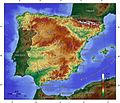Spanish wine
Overview of Spanish wine
Spanish wine refers to the variety of wines produced in Spain, a country with a rich history of viticulture and winemaking. Spain is one of the largest wine-producing countries in the world, known for its diverse range of wines, from robust reds to crisp whites and sparkling wines.
History[edit]
The history of Spanish wine dates back thousands of years, with evidence of viticulture in the region as early as 4000 BC. The Phoenicians and Romans played significant roles in the development of winemaking in Spain, introducing new techniques and grape varieties. During the Middle Ages, monasteries preserved and advanced winemaking knowledge.
Wine Regions[edit]
Spain is home to several renowned wine regions, each with its own unique characteristics and grape varieties.
Rioja[edit]
Rioja is perhaps the most famous wine region in Spain, known for its Tempranillo-based red wines. The region is divided into three sub-regions: Rioja Alta, Rioja Alavesa, and Rioja Baja, each contributing to the complexity of Rioja wines.
Ribera del Duero[edit]
Ribera del Duero is another prestigious wine region, located along the Duero River. It is famous for its full-bodied red wines, primarily made from the Tempranillo grape, locally known as Tinto Fino.
Priorat[edit]
Priorat is a small but highly regarded wine region in Catalonia. The region's wines are known for their intensity and depth, often made from Garnacha and Cariñena grapes.
Rías Baixas[edit]
Rías Baixas is located in Galicia and is renowned for its white wines made from the Albariño grape. These wines are known for their crisp acidity and aromatic qualities.
Grape Varieties[edit]
Spain cultivates a wide variety of grapes, with some of the most notable being:
- Tempranillo: The most widely planted red grape in Spain, known for its versatility and ability to produce wines with aging potential.
- Garnacha: A red grape variety that thrives in the hot, dry climates of Spain, producing fruity and spicy wines.
- Albariño: A white grape variety from Galicia, known for its aromatic and refreshing wines.
- Palomino: The primary grape used in the production of Sherry, a fortified wine from Andalusia.
Winemaking Techniques[edit]
Spanish winemaking techniques vary widely across regions, but some traditional methods include:
- Aging in oak barrels: Many Spanish wines, especially those from Rioja, are aged in oak barrels to add complexity and flavor.
- Fortification: Used in the production of Sherry, where grape spirit is added to the wine to increase its alcohol content.
Types of Spanish Wine[edit]
Spanish wines are classified into several types, including:
- Red wines: Made primarily from Tempranillo, Garnacha, and other red grape varieties.
- White wines: Produced from Albariño, Verdejo, and other white grapes.
- Cava: A sparkling wine made using the traditional method, primarily in Catalonia.
- Sherry: A fortified wine from Andalusia, available in a range of styles from dry to sweet.
Related pages[edit]
-
Tempranillo wine
-
Vineyard landscape
-
Segovia Aqueduct
-
Philip III on Horseback
-
Topographic map of Spain
-
Spanish DO wines
-
Reserva Rioja
-
Galician vineyard
Ad. Transform your life with W8MD's Budget GLP-1 injections from $75


W8MD offers a medical weight loss program to lose weight in Philadelphia. Our physician-supervised medical weight loss provides:
- Weight loss injections in NYC (generic and brand names):
- Zepbound / Mounjaro, Wegovy / Ozempic, Saxenda
- Most insurances accepted or discounted self-pay rates. We will obtain insurance prior authorizations if needed.
- Generic GLP1 weight loss injections from $75 for the starting dose.
- Also offer prescription weight loss medications including Phentermine, Qsymia, Diethylpropion, Contrave etc.
NYC weight loss doctor appointmentsNYC weight loss doctor appointments
Start your NYC weight loss journey today at our NYC medical weight loss and Philadelphia medical weight loss clinics.
- Call 718-946-5500 to lose weight in NYC or for medical weight loss in Philadelphia 215-676-2334.
- Tags:NYC medical weight loss, Philadelphia lose weight Zepbound NYC, Budget GLP1 weight loss injections, Wegovy Philadelphia, Wegovy NYC, Philadelphia medical weight loss, Brookly weight loss and Wegovy NYC
|
WikiMD's Wellness Encyclopedia |
| Let Food Be Thy Medicine Medicine Thy Food - Hippocrates |
Medical Disclaimer: WikiMD is not a substitute for professional medical advice. The information on WikiMD is provided as an information resource only, may be incorrect, outdated or misleading, and is not to be used or relied on for any diagnostic or treatment purposes. Please consult your health care provider before making any healthcare decisions or for guidance about a specific medical condition. WikiMD expressly disclaims responsibility, and shall have no liability, for any damages, loss, injury, or liability whatsoever suffered as a result of your reliance on the information contained in this site. By visiting this site you agree to the foregoing terms and conditions, which may from time to time be changed or supplemented by WikiMD. If you do not agree to the foregoing terms and conditions, you should not enter or use this site. See full disclaimer.
Credits:Most images are courtesy of Wikimedia commons, and templates, categories Wikipedia, licensed under CC BY SA or similar.
Translate this page: - East Asian
中文,
日本,
한국어,
South Asian
हिन्दी,
தமிழ்,
తెలుగు,
Urdu,
ಕನ್ನಡ,
Southeast Asian
Indonesian,
Vietnamese,
Thai,
မြန်မာဘာသာ,
বাংলা
European
español,
Deutsch,
français,
Greek,
português do Brasil,
polski,
română,
русский,
Nederlands,
norsk,
svenska,
suomi,
Italian
Middle Eastern & African
عربى,
Turkish,
Persian,
Hebrew,
Afrikaans,
isiZulu,
Kiswahili,
Other
Bulgarian,
Hungarian,
Czech,
Swedish,
മലയാളം,
मराठी,
ਪੰਜਾਬੀ,
ગુજરાતી,
Portuguese,
Ukrainian







